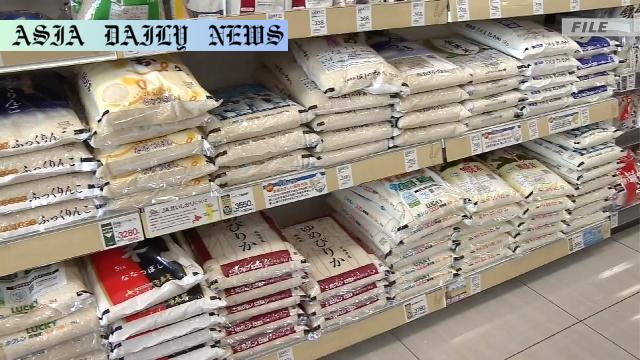Rice prices at supermarkets across Japan continue to climb, reaching double their value from a year ago, despite stockpile releases.
- Rice prices in Japan have increased for the 16th consecutive week.
- The average price for a 5-kilogram bag rose to 4,220 yen or $29.
- Despite governmental release of stockpiles, prices remain high.
- Prices are now double compared to a year ago.

Japan’s Increasing Rice Market Challenges
Over the past 16 weeks, rice prices in Japan have shown a remarkable and troubling trend of steady increases. According to the most recent reports from the agriculture ministry, the average price of a 5-kilogram (about 11 pounds) bag of rice has escalated to 4,220 yen, equating to approximately 29 USD by current exchange rates. Just a year ago, consumers purchased the same amount for slightly over 2,000 yen—a striking doubling of prices in just 12 months.
Economic experts attribute this rise in rice prices to a combination of factors, including increasing demands, supply chain issues, and changing market dynamics. The recent release of national stockpiles was expected to temper the rising prices, but so far, it appears to have had little sustained impact. Released stockpiles first hit the market in March and continue monthly, with the third major auction taking place just last week.
Impacts on Consumers and Retailers
For Japanese consumers, the escalation in rice prices translates to mounting stress on household food budgets. Rice, a staple food in Japanese cuisine, holds cultural as well as economic significance. Many households, therefore, find themselves struggling to adapt to these unexpected price surges, cutting costs in other areas or switching to lesser-quality grains when possible.
Supermarkets are reporting mixed responses, with some customers cutting back on purchases or downsizing their usual orders. Others have had no choice but to absorb the higher costs. Discount retailers have attempted to soften the blow by offering promotions, though these are often brief and unable to sufficiently counter the ongoing price trends. Some experts fear that if the price hikes continue, it could influence broader inflation within the region’s food markets.
Government Actions and Remaining Challenges
The Japanese government has been proactive in releasing stockpiles of rice in an effort to bring prices back under control. These auctions were initially welcomed as a measure to stabilize the market, but their effectiveness is increasingly being questioned. While national stock levels are substantial, the underlying supply chain inefficiencies remain unresolved.
Additionally, economic analysts have pointed to potential external pressures such as rising demand for rice exports, particularly from regions experiencing shortages. Global challenges, including fluctuating weather patterns and geopolitical tensions, have only further highlighted the fragility of food supply systems. If left unchecked, the current trend could escalate into a crisis impacting not only Japan but potentially regional trading partners as well.
Looking Forward: Steps to Mitigate the Crisis
Addressing Japan’s rice price crisis will require a multi-tiered approach. On one hand, interventions at the supply chain level are critical, from improving logistics to investing in local production capabilities to ensure self-sufficiency. On the other hand, supporting consumers through subsidies or food assistance programs may be necessary to alleviate the immediate pressures on low- or fixed-income households.
As government officials prepare for the next stockpile release later this month, there is hope that the ongoing measures will at least moderate price increases in the lead-up to summer. However, experts caution that without addressing root causes, such as production limitations and export pressures, prices may fail to return to their pre-increase levels anytime soon. For now, the nation watches closely as policymakers and industry leaders strategize their next moves.



Commentary
Concerning Trends in an Essential Market
The surging rice prices in Japan are an alarming development, especially given how integral rice is to both daily life and cultural identity in the region. While the consistent rise may seem like just another economic indicator, digging deeper reveals a cascading set of issues that could intensify if left unaddressed. Supermarkets and households alike are bearing the brunt of these changes, and for some families, the increased expense is becoming a significant burden.
What stands out most is the apparent inability of measures, like releasing government stockpiles, to effectively stabilize prices. While such actions provide temporary relief in some markets, the doubling of prices over a year suggests that deeper issues—such as supply chain inefficiencies and global economic challenges—are heavily at play. Without a more radical intervention, the situation risks snowballing further, particularly if inflationary pressures continue to mount in interconnected economies across Asia and beyond.
Another striking element is how this price surge reflects broader global patterns in food insecurity and market volatility. Countries worldwide are grappling with shifting agricultural landscapes and erratic weather patterns, which impact food production. For Japan, a nation reliant on careful balance in its imports and exports, such challenges hold profound implications.
As a personal reflection, these developments are a stark reminder of how interconnected economic systems truly are. Whether through better resource management, consumer assistance programs, or innovative farming techniques, sustainable solutions will need to be developed to safeguard against longer-term impacts. The resilience of households and communities should remain a central focus as Japan works toward ensuring food security for its population during this difficult time.